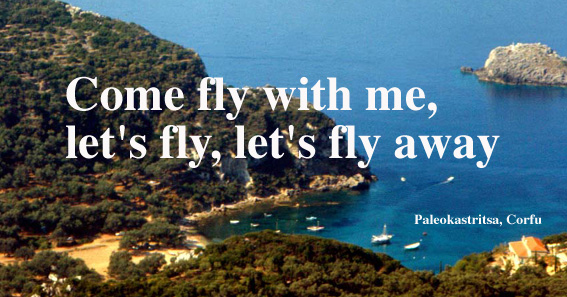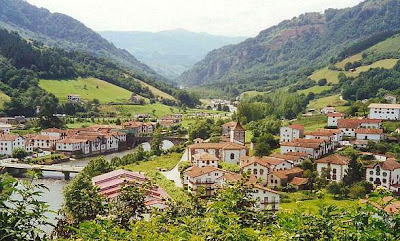Green Galicia
Santiago! This sanctus in stone, surrounded by softly rolling hills, has been a magnet for centuries. Pilgrims wearing the cockleshell emblem of St James (after whom Santiago is named) have been braving these same hills (and the brigands who once roamed them) since medieval times
 Santiago cityscape
Santiago cityscape
Santiago! This sanctus in stone, surrounded by softly rolling hills, has been a magnet for centuries. Pilgrims wearing the cockleshell emblem of St James (after whom Santiago is named) have been braving these same hills (and the brigands who once roamed them) since medieval times
 Santiago cityscape
Santiago cityscapeQuick. What images does Spain evoke for you? Vast ochre plains. Oranges, roses, blood and sand. Flamenco passion. Yes, Spain is all of these. But green and misty? Never.
But Spain is green - a lot of it. The rain in Spain falls mainly up in the Northwest, blown in from the Atlantic and trapped behind the mountains which separate the green from the brown. Here, in Asturias and Galicia, is a pastorale more akin to Wales than Iberia. This is an unexpected region of lush green hills and valleys, richly historic and with independent ways. It is a land of soft speech, soft horizons and a memorable cuisine that owes much to the sea. You can never fully know Spain until you have travelled this way.
My journey to Galicia started, as most Spanish journeys start, in Madrid. My friend at the Spanish Tourist Office mapped out my route in advance, so that I'd be sure to see the best of the north country and he arranged parador accommodations, too. All I had to do was pick up my car at Madrid's Barajas airport and head for the highway, for the drive north.
On your first day, you'll drive north from the city on the N VI, the La Coruna expressway, until you reach a place called Benevente, 260 km away. It's a good road, so if you leave at a reasonable hour, you'll arrive in Benevente in time for lunch (which never starts till 1 pm in Spain). Follow the sign to the local parador for lunch; it's set up on a hill with a view over a river and woods. Much of the countryside around Benevente is flat and grain elevators are much in evidence. Lunch over, you have another 120 km or so, through interesting country (including one spectacular section, close to Benevente, where the terrain is vivid terracotta). You're on the road to Orense now, with your first stopover coming up at Verin. The parador here is close to the little town; you'll see it long before you reach it, for it sits on top of a high hill, almost in the shadow of a restored castle. There's a pool here, surrounded by beautiful gardens, so you can splash about and cool off after your drive and enjoy the panoramic views. At dinner, you can watch the sun set behind a mountain ridge that is, in fact, Portugal.
Before you leave next morning, be sure to spend an hour exploring the old castle of Monterrey, with its square 15c keep, three defensive walls and exquisite 13c church. It played an important role in the Spanish-Portuguese wars, and occupies a commanding position overlooking the plain below. An old caretaker will let you into the church - and if you're in luck, the fig trees will be bearing ripe fruit to take with you when you go.
On this, your second day, you continue your drive west, bypassing Orense and taking the N541 to Pontevedra. You'll cross a mountain pass, so keep your camera handy. With this barrier passed, you have left the more familiar tawny Spain behind you and have entered the green world of Galicia. Pontevedra is an old, slightly down-at-heel port city set at the mouth of a ria, or coastal inlet. Spain's west coast has many such rias, and you'll be visiting one tomorrow. For the moment, look for the parador down by the bridge; it was once a noble mansion and its dining room serves delicious food. Your menu will have all the regional specialties - try caldo gallego, local soup made from salt pork, white beans and turnip greens (which you'll see growing in vegetable gardens all over Galicia). The local mussels and shrimp are worth tasting, too. They come to your table fresh from the ria, just a few minutes away. And, of course, you'll wash all this down with the famed local vino de ribeiro; the red is dry and full-bodied, the white straw-coloured and fruity.
In truth, there's not really much to see in Pontevedra, apart from a few churches and the local museum. So, on your third day, head across the bridge and look for the road to El Grove- it's the first on the left at the end of the bridge. This road hugs the ria's shore line and you'll see many typical Galician sights on the way. The surface of the ria, which reminds many of a Norwegian fjord, will be silver, broken here and there by an armada of black pontoons. Under these pontoons, trailing deep into the water and unseen to the visitor's eye, are long ropes, thickly encrusted with mussels. In the little villages you pass, look for stone grain warehouses, called horreos. Some are plain, some ornamented - but all are built the same way, on stone stilts, so they're above ground. And all have slabs set at right angles to the stone supports, to prevent rats from sneaking up to steal the ripening corn.

When you reach El Grove, park by the statue which honours local fishermen and walk the length of the pier. This place is well-known throughout Spain for its harvest of fish and shellfish. The day I was there, I watched, fascinated, as families busied themselves on little fishing smacks moored to the pier. Some were peeling mussels off ropes and sorting them for market, others were off-loading slithering sardines into flat boxes of crushed ice. The local ladies were clopping about in wooden clogs, curiously ridged at sole and heel, the gulls were wheeling and crying overhead, the whole place smelled wonderfully salty and fishy. It was great fun. When you've seen all the sights, drive on around the coast until you reach the main road, the E 50. From the turn-off, Santiago de Compostela is only a few minutes away.
Santiago! This sanctus in stone, surrounded by softly rolling hills, has been a magnet for centuries. Pilgrims wearing the cockleshell emblem of St James (after whom Santiago is named) have been braving these same hills (and the brigands who once roamed them) since medieval times. Kings and princes and paupers have made their way over mist-wreathed roads to get here and stand before the silver casket containing the saint's remains. His bones were discovered in a field here, with a guiding star shining brightly in the sky. Thus, campo de estrellas or field of stars, shortened over the years to Compostela. Santiago de Compostela is a place of pilgrimage, as venerable as Rome or Jerusalem. You'll drive through a maze of streets, guided by signs (look for Hostal de los Reyes Catolicos) until you finally reach the great plaza in front of the cathedral. Here you'll find not only the cathedral but also your hotel, a 5-star wonder because - well, everyone deserves a treat like this at least once!
The Hostal de los Reyes Catolicos was founded by the Catholic Monarchs Ferdinand and Isabella as a pilgrim inn and hospital. It is vast, with four inner patios, each named after an apostle, and a magnificent carved Plateresque entrance. Restoration of the building by the Spanish government has been impeccably accomplished; the place is the last word in comfort and style and yet it maintains the mood of its historical past. From here you can easily explore Santiago - its narrow streets (which are even more beautiful in the rain), its shadowed stone arcades, its many churches and its towering cathedral. In the latter, be sure to see the Portal de la Gloria, carved in the 12c and a masterpiece of creativity. See, too, the silver casket of St James, placed in a niche under the High Altar. And for a grandstand view, climb the marble steps behind the altar; you can peer over the shoulder of the great carved, gilded head of St James onto the scarlet robes, guttering candles and kneeling congregation below. If you are here in a Festival year, you're in luck - fireworks at night and a cathedral spectacular (see video below). Santiago is a university town, and inclined to be moist So I wasn't at all surprised when my afternoon stroll took me past several Fabricas de Paraguas, or umbrella makers.
Spend your fourth day here, because there's so much to do and see. You can spend the morning of day five here, too, if you like. But in the afternoon, pack your bags and drive the short distance north to La Coruña. There's no parador here in this elegant Galician seaport, but there are many good hotels. I stayed at the Finisterre, which I can recommend. It's reasonable and it offers you a stunning view of the harbour and the city.
La Coruña, or Corunna as it is sometimes called, is Galicia's capital city, with a population of close to 200,000. Its history is closely linked to Spanish sea power; it was from La Coruña that the armada of Philip II set out after his first fleet was destroyed near Cadiz. Built on a rocky inlet, encircling a natural harbour, the city is best known for its sweeping Avenida de la Marina and the tall houses with glazed balconies which line it, overlooking the water. The sight of all this glass turned to flame by the setting sun is unforgettable. In La Coruña, I was reminded of San Francisco, or Sydney. It's a handsome place, architecturally rather un-Spanish. Its most distinctive landmark is a ancient lighthouse, the Hercules Tower. Seventeen hundred years after it was built, it still functions.
On your sixth day, it's time to start thinking about the trip back to Madrid. I suggest you take the N VI back to Benevente, where you stopped for lunch, and stay overnight in the parador. Or stay in Leon, a little further to the north, where you can see the cathedral with its glorious stained-glass windows. The green of Galicia is behind you now; once you've crossed the sierra, the sun starts to bronze the surrounding countryside. On your seventh day, you'll have a relaxed drive back to the capital, stopping in Segovia for lunch and arriving in Madrid in time for dinner.





